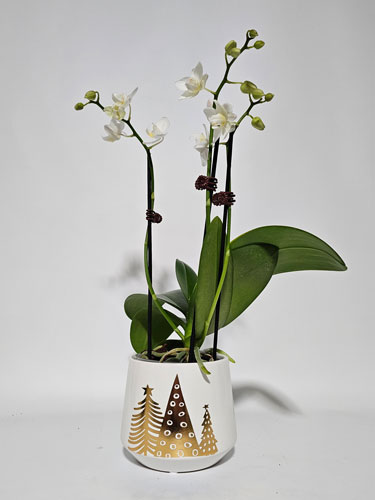Grow moth orchids
Moth Orchids originate from Southeast Asia, New Guinea and Australia. These tropical beauties are easier to care for than their exotic looks might suggest.
In the mid 1800’s, when they arrived in the UK, they triggered a collectors’ feeding frenzy, dubbed ‘Orchidelirium’. Wealthy collectors eagerly pursued rare specimens building elaborate orchid houses for their prized acquisitions. Queen Victoria herself was a fan.
Lucky for us, today’s moth orchids have attained even greater beauty and variety. They come in a wide range of colours and patterns, from crisp white, a popular choice for Christmas, to soft lemon and a wide variety of subtle pinks to intense mauves. Each flower may stay open for several days to weeks before being replaced by another, which means flowering lasts for many months.
Getting your moth orchid plants to prosper and re-bloom is a matter of achieving the correct balance of light, moisture, warmth and nutrients. Orchids thriving in their natural wild habitat provide the clues. They are often found growing in tropical forest canopies as epiphytes, where there is plenty of light but not direct sunlight and their roots are never sitting in water.
The best position for your Moth Orchid at home is where there is plenty of indirect light, but not in a window where sunlight could burn the leaves. They also like some gentle airflow, so a ‘breezy’ spot or where there is a ceiling fan nearby is ideal in summer.
Waterlogged roots bring orchids to a sad end, but they will thrive on modest nutrition. To achieve the correct root environment and nutrition, look for specialised orchid foods, orchid growing mixes and special orchid pots in garden centres.
The fleshy roots are ideally left undisturbed for as long as possible, but cramped plants can be re-potted, every two or three years for vigorously growing plants, in spring.
Check list for flowering
Once your flower spikes have finished flowering, make a clean cut above the first strong bud (usually around 20cm above the pot surface). If your Moth Orchid seems reluctant to return to bloom after 6-8 months:
- Make sure it has enough light. A spot that’s too dark is one of the reasons orchids refuse to re-bloom.
- Make sure you are feeding according to instructions with a good quality orchid fertiliser. This will provide the correct balance of nitrogen, phosphorus, and potassium and trace elements needed for quick re-blooming with larger and more beautiful blooms.
TIP: To provide the humid conditions that tropical rainforest plants love, sit your orchid plant on a dish of decorative pebbles, partially filled with water so that the pot never sits in water.


Feature article from Gellerts Nursery. For further information and more inspirational planting ideas, visit www.gellerts.co.nz
15-Nov-2023



